|
Copyright © 2005 David Silver.
THE 1912 SENECA FOLDING ROLL FILM CAMERAS FROM THE FILES OF THE "WHAT WERE THEY THINKING?" DEAPARTMENT! by David Silver 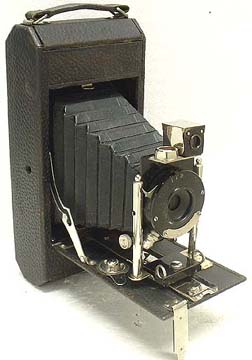 An original 1912 No.1A "Senco" or Seneca Folding Roll Film camera. After more than 30 years of collecting and studying the history of photography, I still run across the occasional camera or photographic gizmo that makes me pause and wonder, "What were they thinking?" Here and in future issues of Camera Shopper, I'm going to share some of those oddities, as I revisit my old "favorites" or unearth new mysteries. They're not the most valuable pieces, or items of particular historical merit, but they'll mystify, delight, and surprise you in their own special ways. The Seneca folding roll film cameras of 1912, for example, were just such a product, and I believe the perfect introduction to the "What were they thinking?" department. The Seneca Camera Company was founded in Rochester, New York, in 1900, and for two decades was one of the most prolific camera manufacturers in the United States. They offered a full range of equipment, from the simplest cardboard box cameras to professional large format rigs. Through an aggressive advertising campaign and a marketing strategy stressing variety and quality at reasonable prices, they held their own against their dominant rival, the giant Eastman Kodak Company. 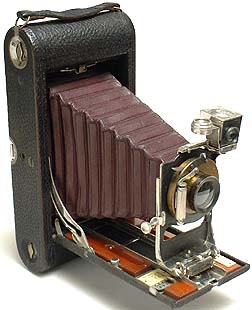 A classic 1905 No. 3A Folding Pocket Kodak, a design Seneca sought to emulate. In 1912 Seneca tried to duplicate the success of their competitor's Folding Pocket Kodak series, but with a twist that would set their own product apart. Rather than modeling a blatant clone, their initial endeavor was the No. 1 and No. 1A Seneca cameras (listed in catalogs as the Seneca Folding Roll Film cameras, or occasionally the "Senco" series), boasting a major improvement that would simplify the process for all amateur photographers. Unfortunately, that "improvement" turned into an imbroglio for Seneca, as they produced one of the classic lemons of camera engineering instead. Externally the No. 1 and No. 1A Seneca cameras resembled most other generic roll film models that were following in the footsteps of the Folding Pocket Kodaks. They featured vertical format orientation, manual bellows extension, a waist level viewfinder, and a selection of different quality lenses and shutters. The No. 1 made 2 1/4 by 3 1/4 inch exposures on #120 roll film, while the No. 1A, which is illustrated here, made 2 1/2 by 4 1/4 inch on #116. The cameras were generally derivative, the quality was mediocre at best, and the overall appearance was drab, but closer inspection revealed an unusual difference in construction. The ends of the body tapered off as angled flat surfaces rather than the smoothly rounded contours of other cameras, and there were deeply incised lines near the edges. Did this have something to do with Seneca's "improvement", or was it merely a stylistic effect? Turning over my example of the No. 1A Seneca reveals the answer. 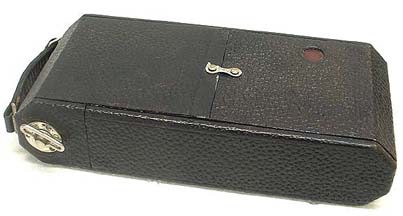 The unusual center clasp back of the 1912 Seneca cameras. While virtually every other folding roll film camera of that time provided a removable rear panel to access the film chamber, the Seneca had a pair of hinged doors that locked precariously in the middle with a hook and pin. The hinges were placed well around the ends of the camera so that they attached near the front. What's more, when the doors were open, the entire corner section of the body supporting the film advance knob was spring loaded so that it could be pulled out to release the spool. There's no doubt the Seneca engineers succeeded in simplifying the loading process, but, well, what were they thinking? Even under the best of conditions, it was impossible to maintain a light tight seal with this wayward concept over time. Seneca soon realized their mistake, at least before they embarrassed themselves further with larger No. 3 and No. 3A models, and the split back cameras disappeared after their 1913 catalog. 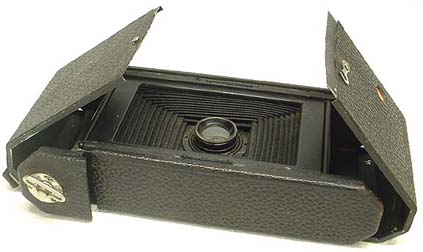 A lot of things hinge and spring out when you open the back of a 1912 Seneca! The following year saw the introduction of the improved and more attractive Seneca R.F. (for roll film) folding camera series that featured a return to the conventional, and undeniably light tight, rear panel over the film chamber. Despite the failure of the previous Seneca camera, the R.F. models sold moderately well for nearly a decade, although the engineers couldn't help themselves from making one last change. As if in overcompensation for their prior design transgression, they created an overly complex central latching system for that rear panel that would have made Rube Goldberg jealous! When next I share some files from the "What were they thinking?" department, you'll hear the story of three folding roll film cameras that apparently got off on the wrong foot...literally! 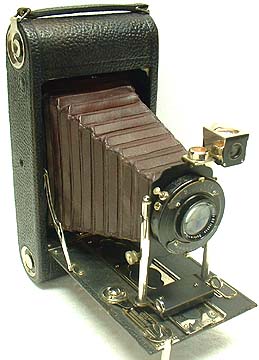 An improved No. 3A Seneca RF camera of 1914, with rare early red bellows. Copyright © 2005 David Silver. All rights reserved. This article first appeared, in slightly edited form, in the June 2005 (issue #156) Camera Shopper magazine. If you'd like to reprint the article, acquire secondary rights, or inquire on the availability of new articles, please feel free to contact the author at silver@well.com, thank you! BACK to the International Photographic Historical Organization article page! GO TO the International Photographic Historical Organization home page! CONTACT the author, David Silver, for more information! |